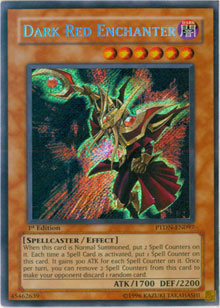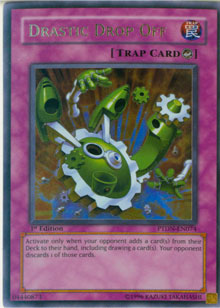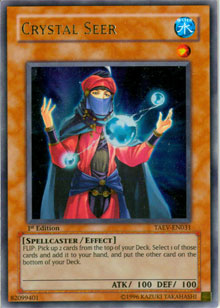
You may have noticed that over the past few weeks there has been a common theme among the decks I’ve presented. If you look back, you’ll find that all of them deal with
prevention. Specifically, what I’m looking to prevent is the intense sequence of plays that allows a player to see half or more of his or her deck in a matter of two turns on the way to a huge victory via
Dimension Fusion or
Return from the Different Dimension. First, we looked at countering each specific play with counter traps with
The War Machine. In the next article, we looked at preventing the plays from ever occurring by dishing out 8000 damage before the opposing strategy could set up. Just last week, we looked at prevention by making the opponent not want to play his cards due to the damage that would result. This week, I want to take a look at a different kind of prevention commonly referred to as pre-negation. Pre-negation deals with removing the possible threats from your opponent’s hand before he or she even gets to play them. In the summer of 2007, players did this by playing three copies of Trap Dustshoot in addition to Confiscation and sometimes Mind Crush. After Confiscation hit the Forbidden list and Dustshoot dropped to one per deck, pre-negation fell by the wayside as there was simply no good way to do it consistently. Thestalos the Firestorm Monarch was seen in virtually every Monarch deck, but that was more or less as a result of him being the second most powerful Monarch at the time behind Raiza. Skip ahead to the release of Phantom Darkness, and suddenly there’s a new tribute monster on the scene akin to a re-usable Thestalos with potentially unlimited ATK . . . and no one is using it! Well, I say "no one," but what I really mean is that the only person I’ve actually seen use it with any degree of success is Derek Rouse, who you may remember from his deck profile in the coverage from
Shonen Jump Championship Columbus. Derek’s deck was interesting in that it’s really the first attempt I’ve seen in months to create a deck based around pre-negation of the opponent’s threats. He used a full complement of both Thestalos the Firestorm Monarch and the new Dark Red Enchanter in addition to a full set of Don Zaloog. While I certainly admire his guts for bringing the deck to the Shonen, I feel there is definite room for improvement on the concept and that perhaps the Tomato Control engine wasn’t the way to go. My main issues with Derek’s deck involve its ability to drop the opponent’s hand a lot faster than it does currently, and I also think that he’s making a big mistake by allowing his opponent to keep the card he or she draws for the draw phase. It’s an unfortunate truth that you can only use Dark Red Enchanter’s discard ability once per turn, but despite this, I’ve come up with a number of play sequences that render this limitation virtually meaningless and do so while putting severe pressure on the opponent to commit everything he or she has to the field or else lose the game in a flash. Here’s what I came up with: 
Monsters: 19
3
Dark Red Enchanter3
Thestalos the Firestorm Monarch3
Apprentice Magician3
Crystal Seer3
Kycoo the Ghost Destroyer2
Cyber Dragon1
Sangan1
Treeborn FrogI’ve seen a number of ideas thrown about as to how this sort of deck might be optimally constructed. Right now, the top contenders are probably either this sort of build or one main-decking Royal Decree to deal with the fact that the opponent is going to be setting his or her trap cards as soon as that player gets them (to avoid being skunked by the multiple discard effects this deck is packing). Personally, I feel that locking myself out of the use of trap cards just to do the same to the opponent is a poor choice. It may just be that most of the decks I build play upwards of ten traps, but I feel like if you’re building your deck without many trap cards of your own and it isn’t a combo deck like Erin Diaz’s Ohm strategy, you’re doing yourself a disservice.
 Despite the fact that Don Zaloog was just reprinted in the Gold Series, I’m not really a fan of him in this strategy since Don needs to deal damage in order to do any discarding, and he’s not really going to manage it without Shrink. I’m not a fan of Shrink right now since it isn’t going to stop Dark Armed Dragon from completely ruining your field, so Don Zaloog will not be appearing in my build. What will be appearing is one of the nastiest counter traps ever to hit the game: Drastic Drop Off.
Despite the fact that Don Zaloog was just reprinted in the Gold Series, I’m not really a fan of him in this strategy since Don needs to deal damage in order to do any discarding, and he’s not really going to manage it without Shrink. I’m not a fan of Shrink right now since it isn’t going to stop Dark Armed Dragon from completely ruining your field, so Don Zaloog will not be appearing in my build. What will be appearing is one of the nastiest counter traps ever to hit the game: Drastic Drop Off.
Drastic Drop Off does everything that normal Drop Off can, except better and with bonus features. Being spell speed 3 counts for something when it’s possible for your opponent to chain a drawn quick-play spell to your regular Drop Off to effectively make you waste a card. While most decks only pack Mystical Space Typhoon in the way of quick-play spells, as time goes by I think we’re going to see an increase in the number of copies of Enemy Controller and Book of Moon in players’ decks—especially once people start realizing how good Book is right now.
The best part of Drastic Drop Off in terms of this particular strategy is that it makes you capable of a guaranteed discard on your opponent’s turn. Normally that one card the opponent draws in the draw phase is totally safe because all of your discard effects are attached to the effect of a tribute monster. There’s almost no way to stop a counter-trap-based discard effect, so your opponents will be plunged even further into the hole as they suddenly find themselves with fewer cards than they expected at the start of their turn. That then leads them to commit everything they’ve got to the field and lets you pick them apart at will.
 One thing we haven’t seen much of since the format switch in March is face-down monsters. With aggression being the name of the game right now, setting monsters just hasn’t been beneficial, unless the monster in question is Spirit Reaper or Marshmallon. Why then, have I chosen to include the Apprentice Magician and Crystal Seer cards? Well, regardless of whether or not you set him, Apprentice Magician is perfect for this deck. You can normal summon or flip him to put another counter on Dark Red Enchanter, multiplying the number of possible discards you can get out of a single Enchanter. Plays where you summon Apprentice Magician to get the second counter on your Enchanter and then flip down the Magician in response to an attack to protect your life points only to search out another and flip it next turn come to mind. The end result of such a sequence of events would be three counters for your Enchanter in addition to having another monster out that can be traded to the opponent with Creature Swap (gaining another counter) or used as a tribute for Enemy Controller to steal an opposing monster (still gaining another counter). Overall, across three turns you’ll be able to steal a card each turn from your opponent with the same Dark Red Enchanter. That means any cards you pitch from the opponent’s hand with Drastic Drop Off or Thestalos become bonus discards that further multiply the rate at which your opponent’s options disappear.
One thing we haven’t seen much of since the format switch in March is face-down monsters. With aggression being the name of the game right now, setting monsters just hasn’t been beneficial, unless the monster in question is Spirit Reaper or Marshmallon. Why then, have I chosen to include the Apprentice Magician and Crystal Seer cards? Well, regardless of whether or not you set him, Apprentice Magician is perfect for this deck. You can normal summon or flip him to put another counter on Dark Red Enchanter, multiplying the number of possible discards you can get out of a single Enchanter. Plays where you summon Apprentice Magician to get the second counter on your Enchanter and then flip down the Magician in response to an attack to protect your life points only to search out another and flip it next turn come to mind. The end result of such a sequence of events would be three counters for your Enchanter in addition to having another monster out that can be traded to the opponent with Creature Swap (gaining another counter) or used as a tribute for Enemy Controller to steal an opposing monster (still gaining another counter). Overall, across three turns you’ll be able to steal a card each turn from your opponent with the same Dark Red Enchanter. That means any cards you pitch from the opponent’s hand with Drastic Drop Off or Thestalos become bonus discards that further multiply the rate at which your opponent’s options disappear.
Other notes on the basic operation of this sort of deck can be found in the coverage from Columbus, so I’d like to finish off with a couple of cards that are either unique to my build or represent a potential shift in the metagame. First off, you’ll notice that there are decks (plural) in the Top 16 from Columbus that do not run Mirror Force in the main deck. I know it could be considered blasphemy to do so, but if you think about it, is it really that crazy to run Threatening Roar instead? Forgoing the power of Mirror Force is a huge decision for any deckbuilder to make, but given the success it saw in Columbus I think it’s worth a shot. The benefits of running multiple copies of Threatening Roar as opposed to using Mirror Force in one of those slots include the fact that Roar is chainable to effects like Return from the Different Dimension or Dimension Fusion and can keep you alive in situations where Jinzo would otherwise hose you. In addition, it can keep Gladiator Beast players from doing nasty Test Tiger tricks in their first main phase to clear your back row and set up for an early game Heraklinos. This particular point is likely to become an issue in the next month or two, so it’s worth trying Roar out now to see how it deals with the rest of the field without any other factors overshadowing your decisions.
 Finally, I’m running a full set of Kycoo the Ghost Destroyer cards. I think Kycoo is an excellent card right now, forcing players who want to drop Dark Armed Dragon to do so without being able to activate its effect. Without that effect, Dark Armed Dragon is more or less pointless to play and an easy target for Enemy Controller or Book of Moon. If you stop one Dragon without it being able to remove anything, you can take it down next turn and put a fourth Dark into your opponent’s graveyard (making it impossible to play further Dragons without drawing into Premature Burial or Monster Reborn—unlikely considering that it may have already been discarded, and may still be discarded in the future thanks to Drastic Drop Off).
Finally, I’m running a full set of Kycoo the Ghost Destroyer cards. I think Kycoo is an excellent card right now, forcing players who want to drop Dark Armed Dragon to do so without being able to activate its effect. Without that effect, Dark Armed Dragon is more or less pointless to play and an easy target for Enemy Controller or Book of Moon. If you stop one Dragon without it being able to remove anything, you can take it down next turn and put a fourth Dark into your opponent’s graveyard (making it impossible to play further Dragons without drawing into Premature Burial or Monster Reborn—unlikely considering that it may have already been discarded, and may still be discarded in the future thanks to Drastic Drop Off).
Dark Red Enchanter is an incredibly nasty card that really hasn’t seen the sort of play I expected. Initially, I thought it was because of the once-per-turn limitation of Enchanter’s ignition effect, but now that I’ve really looked at what the card is capable of, I can’t see any reason other than potential speed issues as to why this card has seen nearly no play. Fortunately this makes Enchanter, like Goblin Zombie, one of the easiest Phantom Darkness secret rares to pick up, and if I were you, I would absolutely get them while they’re cheap. I’m convinced that someone is going to come up with the ideal build for Dark Red Enchanter, and when he or she does, you’ll be glad to have a set. Until next time, play hard, play fair, and most importantly, have fun!
-Jerome McHale
jcmchale@andrew.cmu.edu
NEXT WEEK: Some of the many benefits of immortality.